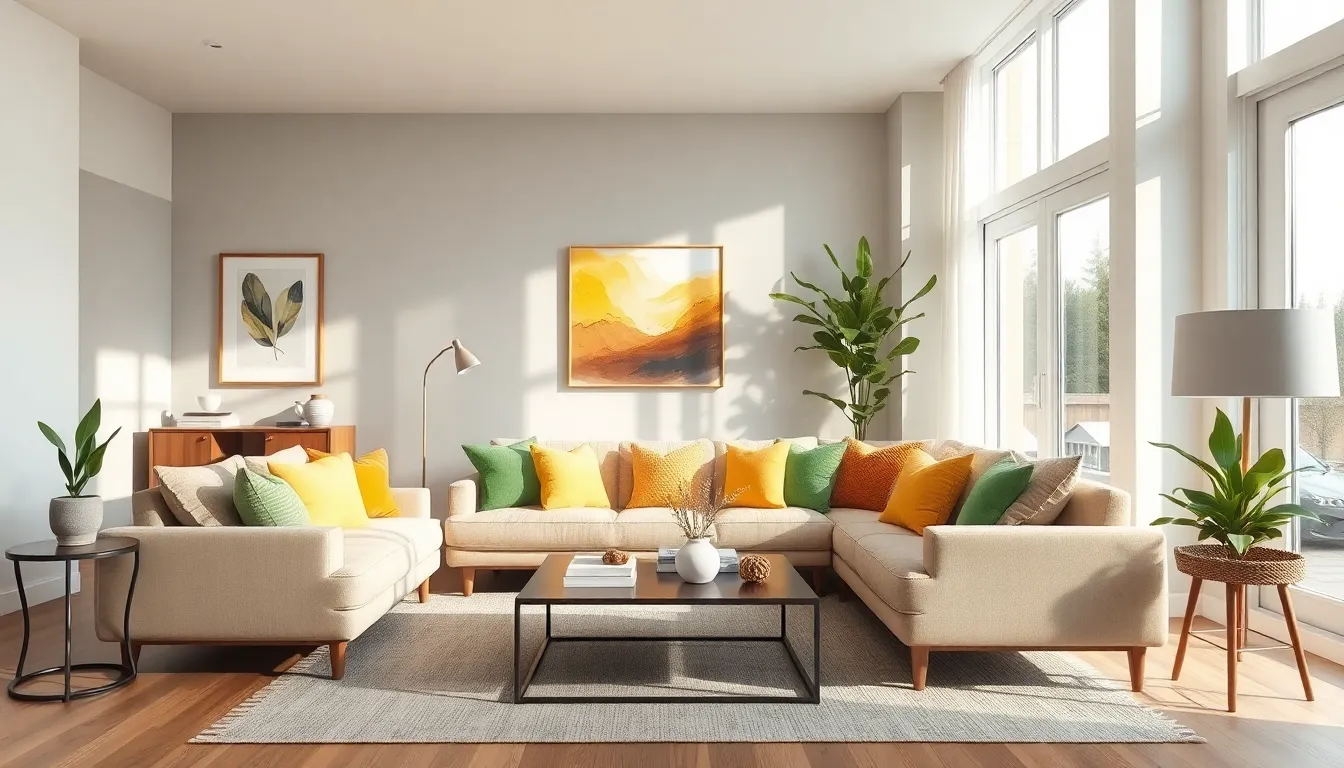Table of Contents
ToggleMoving into a new house is like opening a blank canvas, just waiting for a masterpiece. But before you start slapping paint on the walls like a toddler with finger paints, it’s essential to think about how to turn that empty space into a cozy sanctuary. After all, no one wants to live in a home that looks like a furniture showroom or a museum exhibit.
Decorating a new house can feel overwhelming, but it doesn’t have to be a chore. With the right approach, it can be a fun adventure filled with creativity and a splash of chaos. From choosing the perfect color palette to finding that quirky piece of art that makes guests raise an eyebrow, this journey is all about reflecting personal style. So grab your favorite beverage and let’s dive into the world of home decor, where every room tells a story.
Key Considerations for Decorating a New House
Transforming a new house into a home requires careful thought and planning. Several key considerations can enhance the overall aesthetic and comfort of the space.
Budget Planning
Establishing a budget serves as the foundation for decorating. Adhering to a set budget prevents overspending and ensures choices align with financial limitations. Consider prioritizing key areas like living rooms and bedrooms, where comfort matters most. Divide the budget into categories, including furniture, decor, and materials. Track expenses to maintain clarity throughout the process. Allocating a small contingency fund allows for unexpected costs, ensuring the project remains on track.
Style Preferences
Identifying personal style preferences helps shape the home’s atmosphere. Exploring various design styles, such as contemporary, traditional, or eclectic, provides inspiration. Combining elements from different styles creates a unique space reflecting individual taste. Consider the usage of color palettes that resonate emotionally, enhancing mood. Utilizing accent pieces like rugs, curtains, and artwork adds character and depth. Experimentation with different layouts offers flexibility to find the perfect flow within the home.
Choosing a Color Palette

Choosing the right color palette sets the tone for a new house. A well-curated palette can transform a space, creating an inviting atmosphere.
Understanding Color Psychology
Color psychology plays a significant role in how individuals perceive their environment. Blue often evokes calmness, making it an excellent choice for bedrooms. Yellow stimulates creativity and energy, perfect for kitchens or playrooms. Green connects to nature, providing a refreshing ambience in living areas. Warm tones like red and orange can foster excitement and warmth, making communal spaces feel more inviting. Understanding these associations helps in selecting colors that enhance mood and behavior throughout the home.
Tips for Selecting Colors
Start with existing elements, such as furniture or artwork, to guide color choices. Consider the home’s natural light; bright rooms may suit bolder colors. Create cohesion by using two to three main colors that complement one another. Test shades in small areas before committing to larger spaces; lighting can alter perceptions. Utilize technology, like color visualization apps, to preview combinations. Layering textures with colors adds depth and interest. Final choices should reflect personal style, ensuring the home resonates with its inhabitants.
Furniture Selection and Arrangement
Selecting and arranging furniture requires careful thought. Every choice contributes to the overall design of the space.
Essential Furniture Pieces
Start with foundational pieces for each room. Sofas and armchairs establish comfort in living areas. Dining tables and chairs create gathering spots in kitchens or dining rooms. Beds should provide restful sleep in bedrooms. Storage solutions, like cabinets and shelves, maintain organization throughout the home. Each piece should complement the selected color palette and enhance the home’s style. Personal touches, such as accent tables or unique chairs, add flair to the design.
Layout Ideas for Different Rooms
Explore various layouts to optimize functionality and flow. Living rooms can benefit from a conversational arrangement, with seating facing each other. Dining areas should allow easy movement, placing tables centrally for accessibility. Bedrooms might favor a layout that prioritizes bed placement, considering natural light and views. Home offices need efficient setups, ensuring task-oriented spaces enhance productivity. Flexibility is key; furniture can be rearranged occasionally to refresh the environment and adapt to changing needs.
Incorporating Personal Touches
Personal touches transform a house into a home. Choosing meaningful elements enhances connection and warmth throughout the space.
Adding Artwork and Decor
Incorporating artwork captures personal interests and styles. Unique pieces can become conversation starters and reflect individuality. Consider selecting local artists to support the community while adding character. Displaying a variety of art styles creates visual interest. Mixing framed prints with canvases offers a dynamic gallery feel. Finally, rotating artwork seasonally can keep the decor feeling fresh and relevant.
Utilizing Personal Collections
Showcasing personal collections celebrates individual passions and experiences. Heirlooms, travel souvenirs, or hobby-related items add depth to decor. Displaying collections thoughtfully creates focal points in rooms. Group similar items for visual coherence, while varying heights for added intrigue. Shelves and display cases optimize space, keeping items organized and accessible. Each collection tells a story and invites guests to engage with it.
Lighting and Ambiance
Lighting plays a crucial role in shaping the ambiance of a new house. It not only enhances aesthetics but also impacts mood and functionality.
Types of Lighting Fixtures
Choosing the right lighting fixtures adds character to each room. Ceiling fixtures provide general illumination while pendant lights can create focal points over dining areas. Wall sconces offer both task and accent lighting, enhancing visual interest. Floor lamps serve well for reading nooks and seating areas. Chandeliers elevate elegance, especially in entryways or dining rooms. Task lighting like desk lamps or under-cabinet lights focus on specific activities. Different combinations of these fixtures ensure flexibility and adaptability in lighting design.
Creating a Cozy Atmosphere
Establishing a cozy atmosphere involves more than just light; it includes the quality and warmth of the light itself. Soft, warm light bulbs promote relaxation, making spaces feel inviting. Layering various lighting types enhances depth and dimension throughout rooms. Utilizing dimmers allows for adjusting brightness according to the time of day or mood. Incorporating natural light through strategically placed mirrors can amplify warmth, reflecting sunlight. Adding decorative elements like string lights or candles creates a comforting ambiance. Personal touches, such as selecting shades or fixtures that reflect individual style, further enhance the home’s warmth and character.
Decorating a new house is a journey filled with creativity and personal expression. By focusing on individual style and thoughtful planning, anyone can transform their space into a welcoming haven. The right color palette and furniture arrangement play pivotal roles in setting the desired atmosphere.
Incorporating personal touches and meaningful decor not only enhances the visual appeal but also fosters a sense of belonging. Lighting choices further elevate the ambiance, creating a warm and inviting environment. Embracing this process allows for the creation of a home that truly reflects one’s personality and story.





